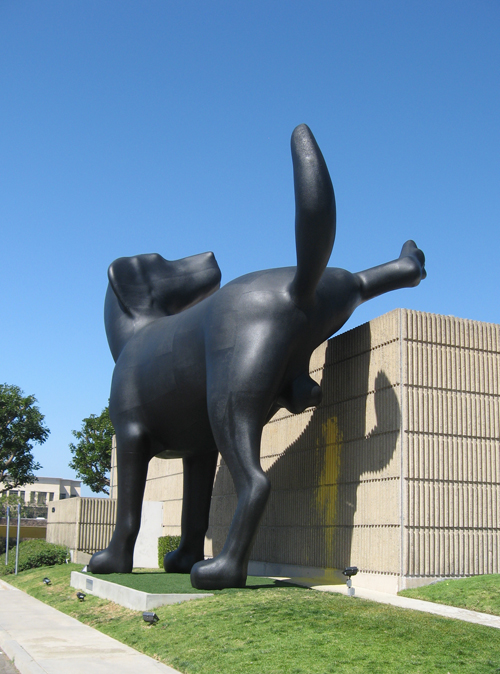Richard Jackson is a maniac with paint. His current retrospective is a testament to the gargantuan ambitions and massive amounts of energy he has displayed over a 40-plus-year career. The exhibition’s title, “Ain’t Painting a Pain,” is indicative of his commitment to the act of painting, although his real achievement as an artist is how he has consistently pushed the boundaries of the painting medium into installation, performance and sculpture, while still retaining a focus upon the act of painting itself.
A Jackson installation from 1980, “Big Ideas—1000 Pictures,” made an unforgettable impact when exhibited at Rosamund Felsen Gallery in Los Angeles with its 1000 painted canvases stacked from floor to ceiling. The radical nature of “the idea” as a way of dealing with painting was unprecedented—it could conceivably be compared to Pollock’s breakthrough drip paintings in its inventive re-thinking of the painting medium. The multi-colored, process-laden pattern, like bricks and mortar, was visually compelling as well. These works were intentionally ephemeral, but the OCMA show features a new similar work, “5050 Stacked Paintings” (2013), a monumental stack of dripping canvases creating a structure akin to terraces. One of the most formally captivating works in the show displays Jackson’s relation to both minimalist and process vocabularies.
The exhibition features work from every period of Jackson’s career, including several wall works from the period 1969–1988 made by pushing heavily paint-coated canvases across gallery walls, another terrific innovation of the painting process. Also included are many of the perspective drawings he has done over the years to plan his projects. In their visual resonance, the drawings are outstanding as works of art themselves and provide an intimate view into the playful musings that eventually resulted in huge projects requiring vast amounts of labor and materials.
“1000 Clocks” (1987-92), which was shown in “Helter Skelter” at MOCA in 1992, seems to mark the mid-point in Jackson’s career. The work he has done since then has been a departure, at least stylistically, from the painting installations of the 1970s and 80s. Jackson’s installations from the last two decades continue the exuberant energy of his earlier, more abstract projects, but the recent work is characterized by the use of representational sculptural forms. Much of his imagery is culled from art historical sources, as well as those reflecting more of a Pop, or Postmodern sensibility.
This work, while impressive, sometimes struggles to transcend spectacle—Bad Dog (2013), a giant dog peeing yellow paint on the museum is a hilarious jab at stuffy institutions, but lacks the complexity and innovation of the painting installations inside. However, “The Blue Room” (2011) is amongst the most successful of the newer installations. Based upon imagery from both Picasso and Duchamp, the painted installation pulsates with an inimitable chromatic energy.
What remains consistent throughout all the work is a love of the substance of paint itself—a highly-saturated, dripping, runny, viscous material. Jackson’s oeuvre wryly deconstructs art’s most enduring and dominant tradition.


